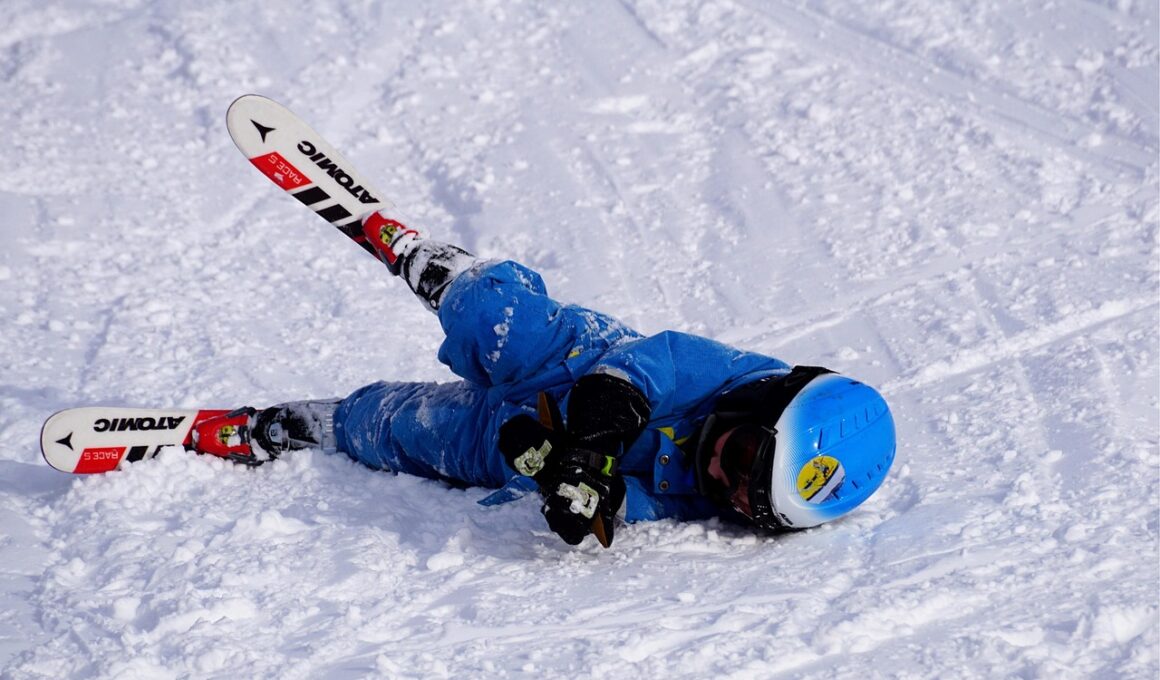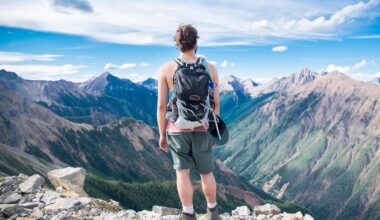Essential Winter Sports Safety Guidelines for Beginners
Winter sports can be thrilling and rewarding, but they also come with inherent risks. If you’re a beginner, it’s essential to prioritize safety. Proper preparation can drastically reduce your chances of injury. First, always wear appropriate gear, including helmets, goggles, and warmth-providing layers. Improper clothing can lead to hypothermia. Ensure your equipment is in good condition and sized correctly. You can consult experienced friends or professionals for guidance. Maintain good physical fitness as well, as strength and flexibility enhance your balance and control on the slopes. Also, never underestimate the importance of a proper warm-up. Stretch your muscles to improve flexibility and circulation. Know your limits; pushing yourself beyond your abilities can result in accidents. Check the weather and slope conditions before heading out, as visibility and snow quality are critical. Take lessons from qualified instructors if you’re unfamiliar with the sport. They teach valuable skills that contribute to your safety. Follow slope etiquette; this ensures a safe environment for everyone. Be aware of your surroundings, and always stay in control. Observe fellow skiers and snowboards; anticipate their movements. These simple practices can enhance safety and enjoyment on the slopes.
Understanding Basic Equipment
Having the right equipment is a crucial aspect of winter sports safety. As a beginner, you should familiarize yourself with essential gear and its functions. Skis, snowboards, poles, boots, and bindings should be correctly matched to your size and skill level. Misfitting equipment can hinder your performance and increase the risk of accidents. For skiing, ensure your bindings are correctly adjusted to release during a fall, preventing leg injuries. Snowboarders should choose the right board length and flex, ensuring it suits their weight and riding style. A good quality helmet is non-negotiable; it protects against head injuries and should fit securely. Goggles are vital for protecting your eyes from UV exposure and increasing visibility in snow. Do not forget warmth; dress in layers to manage body temperature effectively. An insulated jacket, thermal base layers, and waterproof outer shells are essential. Additionally, consider wearing wrist guards for snowboarders and knee pads for skiers. Understanding the function and use of your gear can significantly enhance your winter sports experience. Before heading out, double-check all your equipment to ensure optimal performance and safety throughout your time on the slopes.
Another key aspect of winter sports safety is knowing the ski resort’s rules and regulations. Each facility typically has established guidelines to ensure the safety and enjoyment of all visitors. It’s crucial to familiarize yourself with these rules before you start your adventure. Most ski resorts have marked trails categorized by difficulty. Beginners should stick to green trails to avoid potential hazards associated with more difficult terrains. Also, be mindful of warning signs, which indicate potential dangers such as steep drops or off-limits areas. Staying on designated paths not only safeguards your safety but also protects the environment. Additionally, always read trail maps carefully; they provide details on various routes, lifts, and facilities available. Be aware of the ski patrol and their role in maintaining safety on the slopes. If you find yourself in need of assistance, don’t hesitate to reach out to them. Adequate preparedness and an understanding of the resort’s regulations can go a long way in ensuring a fun and safe experience on the ski slopes. Set aside time to learn these essential safety guidelines before heading onto the mountain.
Weather Awareness
Weather conditions play a significant role in winter sports safety. Understanding how various weather elements impact the skiing or snowboarding experience is essential. Before you head out, check the local weather forecast. This information is vital for planning your day and dressing appropriately for the conditions. Look for updates on temperature, snow quality, wind speed, and potential storms. Wind can be particularly dangerous, creating hazardous conditions, especially at higher altitudes. Snowfall significantly impacts visibility and slope conditions, so be aware of any recent snow or avalanche warnings. Avoid heading out in poor conditions, as this can lead to accidents and injuries. Dressing according to weather conditions not only increases comfort but also contributes significantly to safety. Always bring extra layers, such as gloves, hats, and thermal wear, to adapt to changing weather. Also, consider the time of day; sunlight can diminish, and temperatures can drop quickly in the afternoon, so plan accordingly. Staying aware of weather patterns can ensure you have a safe and enjoyable day on the slopes while minimizing risks associated with unexpected conditions.
Staying hydrated while participating in winter sports is a critical, often overlooked safety guideline. Cold weather can mask feelings of thirst, leading many beginners to underestimate their hydration needs. It’s essential to drink water throughout the day to keep energy levels up and prevent dehydration. Signs of dehydration can include dizziness, fatigue, and decreased performance, which can lead to accidents on the slopes. Pack a water bottle in your gear and take regular breaks to hydrate. Consider using insulated water bottles to prevent your drink from freezing. In addition to water, consider consuming snacks that provide energy, such as granola bars or fruit. These snacks can help maintain your energy levels and keep you fueled throughout the day. Avoid excessive alcohol consumption after skiing, as alcohol can impair your judgment and hydration. Encourage your friends or family members to stay hydrated as well; peer support can enhance everyone’s safety experience. By actively monitoring your hydration levels, you ensure that you remain alert and focused while practicing winter sports, allowing for a safer and more enjoyable time on the slopes.
Importance of Physical Fitness
Physical fitness is integral to the prevention of injuries while engaging in winter sports. Being physically fit allows for improved balance, strength, and coordination, which are vital when navigating snowy terrains. Beginners should consider regular exercise leading up to a winter sports trip, focusing on cardio, strength training, and flexibility exercises. Cardio workouts, such as running or cycling, can help build endurance, allowing you to withstand long days on the slopes. Strength training, particularly in the core and legs, provides the necessary power for maneuvering turns and absorbing shock from bumps. Flexibility exercises, such as yoga or stretching routines, enhance your ability to recover quickly from falls and maintain proper muscle function. Prioritize warm-up exercises before you start skiing or snowboarding, as these prepare your body for the physical demands of the sport. Always listen to your body; if you’re feeling fatigued, take a break instead of pushing through, as exhaustion can lead to careless mistakes and injuries. Conditioning your body through an active lifestyle is crucial for enjoying winter sports safely and reducing potential risks associated with these exhilarating activities.
Following safety guidelines when skiing or snowboarding with friends or family adds another layer of fun and safety. Make your winter sports adventures a social affair by prioritizing group safety practices. Establish a buddy system where you always keep an eye on each other. That way, if someone experiences difficulties, help is immediately available. Ensure you agree on meeting points in case anyone gets separated. This planning is essential in busy resorts where it’s easy to lose track of companions. Communicating openly about skill levels is crucial; stick together on slopes that match everyone’s abilities. Don’t hesitate to speak up if someone is attempting a run outside their comfort zone. Incorrectly assessing one’s ability can lead to serious injury or accidents. Also, avoid using earbuds or headphones while skiing or snowboarding, as these can reduce awareness of your surroundings. Maintaining communication with your group will enhance everyone’s experience by ensuring safe practices are observed. Remember that support and encouragement from your peers can make your time on the slopes more enjoyable while simultaneously prioritizing safety. Gather friends for a collective safe winter sports experience.
Conclusion
In conclusion, engaging in winter sports requires adherence to essential safety guidelines to ensure an enjoyable and injury-free experience. Beginners should be aware of gear basics, slope regulations, weather conditions, and physical fitness importance. Staying hydrated and practicing situational awareness can significantly impact your performance while minimizing risks. Embrace social accountability within your group; this companionship further supports safe practices on the slopes. Understanding your limits and making informed choices regarding risk will enrich your enjoyment of winter sports. Whether it’s skiing, snowboarding, or other winter activities, following these guidelines can guarantee a more secure schedule filled with excitement and memorable experiences. Preparing adequately and respecting the elements of winter sports creates a fun atmosphere where safety is a priority. Consider seeking out lessons or advice from professionals to improve skills while ensuring safety. By taking the time to learn these vital tips, you equip yourself with knowledge that contributes greatly to your winter sports adventures. Embrace the thrill of winter sports journey while keeping safety in mind, creating cherished memories and exhilarating experiences on the snow.


